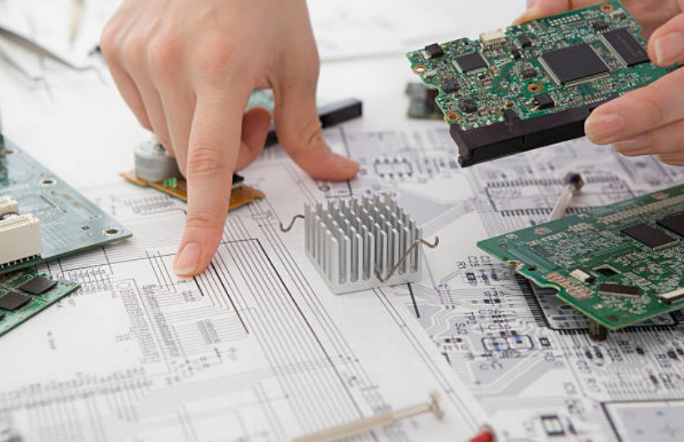High Density Interconnect (HDI) substrates are gaining popularity in the electronic design world due to their many advantages over traditional printed circuit boards. These benefits include increased wiring density, reduced size, and improved electrical performance. In this blog, we will discuss HDI PCB design in detail.
As a design for high-speed serial transmission, to suppress reflection, reduce transmission loss, and suppress noise,
Board design is based on three basic guidelines:
1. Impedance control of differential wiring
2. Minimizing the length of differential wiring
3. Aligning the wiring length within a differential pair as much as possible.
Printed circuit board (PCB) design and manufacturing is changing to meet the growing demand for smaller and more powerful electronic devices. PCB (printed circuit board) design and manufacturing trends include:
High Density Interconnect (HDI) printed circuit boards are gaining adoption due to their superior wiring density, shrinking size, and improved signal integrity.
Application-specific demands require the use of new materials such as flexible substrates and metal-core printed circuit boards.
Using cutting-edge manufacturing techniques such as laser drilling and 3D printing can reduce productivity and costs.
The PCB sector is growing and becoming more innovative, but still faces significant obstacles. Among these difficulties are:
Issues regarding the impact of his PCB manufacturing on the environment include improper waste disposal.
Supply chain issues, such as lack of necessary supplies or parts.
The increasing complexity of designing and manufacturing printed circuit boards (PCBs) has increased the demand for specialized workers.

In terms of suppressing reflections, impedance control can be achieved by optimizing the design specifications not only for the wiring mentioned above, but also for through-holes, and this is becoming popular in digital consumer equipment.
It is essential to optimize the connector considering the impact of the mounting site, and to fully understand the actual characteristics of the cable. For example, if the pattern design of the mounting part of the connector is not appropriate, in many cases, extra parasitic capacitance will be added, the impedance will be lowered, reflection will occur, and the transmission waveform will be poor, so optimization of that part is necessary.
Let's take a closer look at each of these topics.
HDI PCB design is a type of printed circuit board (PCB) design that aims to increase routing density using smaller components and vias. This allows for a more compact design with improved electrical performance. HDI boards are used in high-tech electronics such as smartphones, laptops and medical devices.
The advantages of HDI PCB design are:
• Miniaturization: HDI PCBs can be smaller than traditional PCBs due to their high routing density.
• Improved electrical performance: The HDI circuit board reduces parasitic capacitance and inductance, improving signal integrity.
• More functionality: HDI boards can accommodate more components and thus more functionality.
• Improved thermal management: HDI PCBs can be designed to dissipate heat more efficiently.
• Improved reliability: HDI circuit boards have fewer interconnects, reducing the risk of failure due to solder fatigue and other factors.

There are three main types of HDI PCBs.
• 1+N+1: This type of HDI PCB has one hardened layer followed by a base layer followed by another hardened layer.
• 2+N+2: This type of HDI PCB has two hardened layers, followed by a base layer, and two further hardened layers.
• Optional HDI Layers: This type of HDI PCB has multiple build layers with vias connecting them.
Choosing the right HDI board design for your application Consider the following factors to choose the right HDI board design for your application.
• Number and size of required components.
• Desired PCB size.
• Electrical property requirements.
• Thermal management requirements.
• Available budget.
HDI PCB Stack Design HDI PCB stack design is critical to achieving the required wiring density and electrical performance.
• Signal Layers: These layers carry electrical signals between components.
• Power and Ground Planes: These layers provide power and ground connections to the components.
• Layout Layers: These layers are used to create vias connecting different layers.
HDI Board Layout Guidelines To achieve the desired layout density, certain layout guidelines must be followed when designing an HDI board.
• Minimize the number of vias used.
• Use microvias whenever possible.
• Avoid right angles when tracing.
• Minimum distance between components and vias
HDI boards use several types of vias to achieve the required routing density. These include:
• Through Holes: These vias go through all layers of the PCB.
• Pinholes: These are small diameter vias that connect adjacent layers.
• Blind vias: These vias connect outer layers to inner layers without going through the entire board.
• Hidden vias: These vias connect two or more inner layers without going through the outer layers.
Microvia Fabrication Microvias are a critical component of HDI PCBs and require precision drilling techniques for fabrication. Microvias are created using the following methods:
• Mechanical Drilling: This method uses a drill to create a via. This is the most common method used to drill microvias.
• Laser Drilling: This method uses a laser beam to create a through hole. This is a more precise drilling than mechanical drilling and is used for small diameter holes.
Blind vias are used in HDI PCBs to reduce the number of layers required and increase routing density. The following methods are used for the manufacture of blind transitions:
• Mechanical Drilling: This method uses a drill to create a via. This is the most common method used to drill blind vias.
• Laser Drilling: This method uses a laser beam to create a through hole.
Laser drilling is an important process in HDI PCB manufacturing, requiring precise control of the laser beam. The following types of lasers are used for HDI PCB laser drilling:
• CO2 lasers: These lasers are used to drill larger diameter through holes.
• UV lasers: These lasers are used for drilling small diameter holes.
The surface finishing of HDI PCB is important to ensure good solderability and prevent corrosion. The following surface finishes are commonly used for HDI PCBs:
• ENIG (chemical nickel immersion gold)
• OSP (Organic Soldering Preservative)
• HASL (Hot air solder leveling)
HDI circuit boards require testing and verification to ensure their functionality and reliability. For HDI printed circuit boards, the following tests and checks are commonly used:
• Electrical Tests: This includes short circuit, open and continuity tests.
• X-Ray Inspection: Used to check the inside layers of the printed circuit board for defects.
• Microsection analysis: used to check the quality of vias and other important features.
HDI PCB design requires careful consideration of manufacturability. The following DFM considerations are important for HDI PCBs:
• Minimize the number of layers.
• Follow good routing rules.
• Use the correct type and size of vias.
• Selection of the appropriate surface treatment.
• Minimize the use of blind and hidden vias.
Several design tools are available for HDI PCB design. These tools include:
• CAD software: Use computer-aided design (CAD) software to create the PCB layout.
• DFM Tools: Design Tools for Manufacturability (DFM) are used to ensure the manufacturability of projects.
• CAM Software: Use computer-aided manufacturing (CAM) software to create data files needed for PCB manufacturing.
HDI PCBs offer a number of advantages over traditional PCBs. These benefits:
• Increased wiring density
• small size
• Reduced signal noise
• Improved signal integrity
• Improved temperature management
HDI PCBs are used in a wide variety of applications, including:
• mobile devices
• Wearable technology
• Medical equipment
• Aerospace and Defense
• Automotive electronics
• Industrial automation
There are several challenges in designing and manufacturing HDI PCBs.
• High price
• Complex production process
• tight tolerances
• Limited design flexibility
Demand for smaller, lighter and more powerful electronic devices is driving the development of HDI PCBs. The future of HDI PCB may include:
• Greater use of new materials such as flexible substrates.
• Advances in laser drilling and other manufacturing technologies.
• Integration with 3D printing and other additive manufacturing technologies.
HDI PCB is a key technology to meet the demand for smaller and more powerful electronic devices. Designing and manufacturing HDI PCBs requires careful consideration of factors such as trace density, via type, surface quality, and testing and verification. HDI PCB presents some challenges, but its advantages make it an important technology for many applications.
By continuing to use the site you agree to our privacy policy Terms and Conditions.
Recruit global agents and distributors Join us